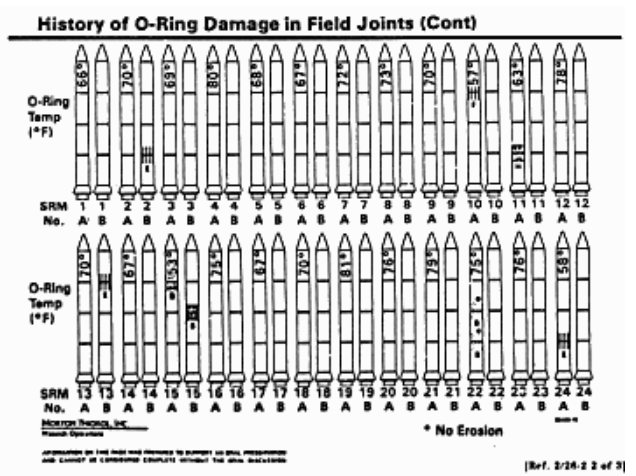A day before the 1986 launch of the Challenger, a team of engineers urged NASA to postpone, arguing that launching in cold weather would be extremely dangerous. Parts called "O-rings", they said, were likely to crack in cold weather. A cracked O-ring could lead to a catastrophic explosion – and the death of every astronaut onboard.
Mission control asked the engineers to explain this risk with data.
To make their case, the engineers created an infographic that displayed outlines of 48 rockets, each representing a previous launch. Each rocket was labeled with the temperature at launch, with marks showing O-ring damage. These marks were explained in a legend, to help mission control understand what the damage was.
 An infographic conveying O-ring damage in 48 rockets
An infographic conveying O-ring damage in 48 rockets
Unfortunately, their infographic was very hard to read:
-
Instead of sorting the rockets by temperature or amount-of-damage (the two variables the engineers claimed were related!), they were sorted by…the date they launched.
-
The temperature at launch, which was the most important thing the engineers wanted mission control to see, was written sideways, in a tiny font that was difficult to read.
-
The marks showing O-ring damage were hard to understand, and the legend that explained them was on a separate page!
The engineers created an infographic that failed to clearly explain the risk, and mission control made the decision to go ahead with the launch.
73 seconds into the flight, the rocket exploded over the coast of Florida, killing everyone onboard. The tragedy crippled NASA, which did not launch another rocket for nearly three years.
…The Challenger’s explosion was, in the end, attributed to O-ring failure.
These materials were developed partly through support of the National Science Foundation, (awards 1042210, 1535276, 1648684, 1738598, 2031479, and 1501927).  Bootstrap by the Bootstrap Community is licensed under a Creative Commons 4.0 Unported License. This license does not grant permission to run training or professional development. Offering training or professional development with materials substantially derived from Bootstrap must be approved in writing by a Bootstrap Director. Permissions beyond the scope of this license, such as to run training, may be available by contacting contact@BootstrapWorld.org.
Bootstrap by the Bootstrap Community is licensed under a Creative Commons 4.0 Unported License. This license does not grant permission to run training or professional development. Offering training or professional development with materials substantially derived from Bootstrap must be approved in writing by a Bootstrap Director. Permissions beyond the scope of this license, such as to run training, may be available by contacting contact@BootstrapWorld.org.